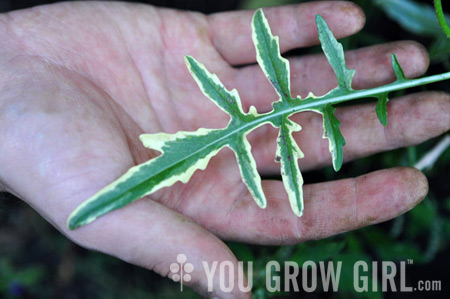
Perhaps it is because I have a penchant for the weird and the unusual, or maybe it’s because I just think it’s pretty, but I seem to have a strong affinity for variegated plants. It doesn’t matter what it is, if there is a variegated version, I must have it.
Well, that’s not entirely true. Some variegated plants have an unhealthy, diseased appearance that is unappealing. Sometimes a sickly look is more than aesthetic. Variegation in plants can occur when cells get confused, causing a mutation that results in a lack of chlorophyll or certain pigments. Sometimes this happens spontaneously but disappears, and at other times it keeps going and spreading as the plant continues to grow.
Some variegated plants can be difficult to keep alive, especially when they produce foliage with no chlorophyll at all. I see this with my variegated citrus trees fairly often. The parts with little to no chlorophyll tend to be weaker than other parts of the plant and more susceptible to problems with pests. Watch your plants and see for yourself. But it’s worth the hassle. I love watching the way the new leaves form. It’s exciting to see what will happen next. With regular plants you always know what will come next, unless of course a spontaneous mutation occurs. A little surprise from nature.
The other day, Davin discovered variegation in some of the arugula aka rucola selvatica (Diplotaxis tenuifolia) growing at our Yardshare Garden (photo above). It’s so pretty! We’re very excited about it, but also feel a bit out of our depth and unsure about how to go about maintaining and even encouraging it to spread. I have never seen or heard of variegated arugula before, and am doubtful that we can get it to stabilize. Most of these sorts of spontaneous mutations revert back to green. It’s obviously in the plant’s best interest to do so.
I checked on the plant last night, and the variegated stem has flowers on it. We’re going to let it go to seed and see what happens when we plant it next year. Probably nothing, but it seems worth a shot. The best way to isolate variegation is by taking cuttings, but I have to admit that I’ve never tried taking cutting from arugula before. It’s so pervasive in the garden and easy to grow from seed, I’ve simply never had reason to.
Fortunately, this particular crop has proven to be very cold hardy. Some of the plants in that section have been growing since last year and seemed to overwinter with no effort on our part. Chances are that we’ll see this again next year.
Either way, this has become a fun diversion and a nice excuse to dip into the more scientific side of gardening for a change. If you’re interested in this side of things like I am, I suggest “Botany for Gardeners” by Brian Capon. It doesn’t say much about the topic of variegation, but there is lots of information about how plants develop and evolve, all presented in a way that is understandable to gardeners with no more than high school level science.
Have you noticed any spontaneous variegation on your plants?
Wow that is cool. Does it taste the same as the regular arugula? I too have noticed that Arugula has survived a few frosts, this year, in my garden, and the frost has not affected the taste. I’m in zone 3 so it will be interesting to see if it is still there next spring.
Thanks for such a good explanation, I’m going to reserve that book at the library right now.
I hope you get some next year, its very nice looking.
This is an extraordinary spontaneous mutation! I hope you can get it to stabilize. A seed of this sort would be in high demand. I’ve never seen anything like it, and as you said, unlike many variegated leaves that look a little sickly, this one looks tasty.
I am a co-founder in the Toronto Tech Start-up company Aden Earth. Our first project is http://ThePlantEncyclopedia.org , a project which I think you might enjoy. Upon launch this should prove the most definitive global reference for cultivated plants. In the office we all admire your writing and I hope to meet you someday soon.
I haven’t noticed any spontaneous variegated but I just planted some variegated hostas. The great thing about gardening is sharing. So I went to a customers house today and she offered me so many options. It’s great to get free stuff and help her clean out her garden!.
I have a euphoria breathless blush that is mixed with a coleus and they have started to form this beautiful mix of leaves that are a mixture of both colors!!